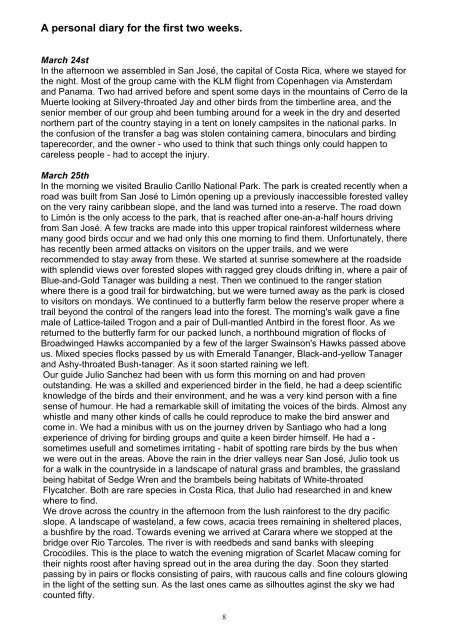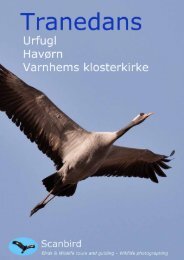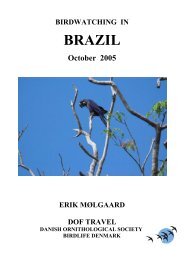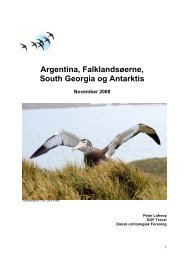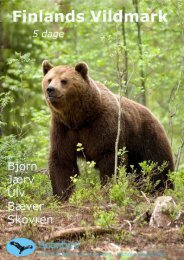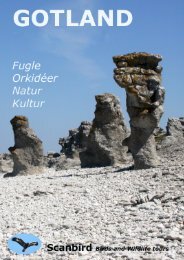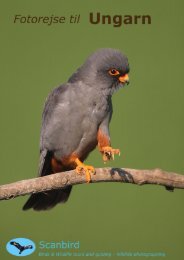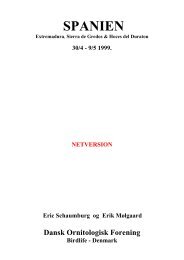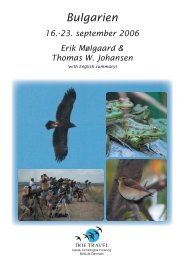Costa Rica Mar. - Apr. 1996 - Scanbird
Costa Rica Mar. - Apr. 1996 - Scanbird
Costa Rica Mar. - Apr. 1996 - Scanbird
Create successful ePaper yourself
Turn your PDF publications into a flip-book with our unique Google optimized e-Paper software.
A personal diary for the first two weeks.<br />
<strong>Mar</strong>ch 24st<br />
In the afternoon we assembled in San José, the capital of <strong>Costa</strong> <strong>Rica</strong>, where we stayed for<br />
the night. Most of the group came with the KLM flight from Copenhagen via Amsterdam<br />
and Panama. Two had arrived before and spent some days in the mountains of Cerro de la<br />
Muerte looking at Silvery-throated Jay and other birds from the timberline area, and the<br />
senior member of our group ahd been tumbing around for a week in the dry and deserted<br />
northern part of the country staying in a tent on lonely campsites in the national parks. In<br />
the confusion of the transfer a bag was stolen containing camera, binoculars and birding<br />
taperecorder, and the owner - who used to think that such things only could happen to<br />
careless people - had to accept the injury.<br />
<strong>Mar</strong>ch 25th<br />
In the morning we visited Braulio Carillo National Park. The park is created recently when a<br />
road was built from San José to Limón opening up a previously inaccessible forested valley<br />
on the very rainy caribbean slope, and the land was turned into a reserve. The road down<br />
to Limón is the only access to the park, that is reached after one-an-a-half hours driving<br />
from San José. A few tracks are made into this upper tropical rainforest wilderness where<br />
many good birds occur and we had only this one morning to find them. Unfortunately, there<br />
has recently been armed attacks on visitors on the upper trails, and we were<br />
recommended to stay away from these. We started at sunrise somewhere at the roadside<br />
with splendid views over forested slopes with ragged grey clouds drifting in, where a pair of<br />
Blue-and-Gold Tanager was building a nest. Then we continued to the ranger station<br />
where there is a good trail for birdwatching, but we were turned away as the park is closed<br />
to visitors on mondays. We continued to a butterfly farm below the reserve proper where a<br />
trail beyond the control of the rangers lead into the forest. The morning's walk gave a fine<br />
male of Lattice-tailed Trogon and a pair of Dull-mantled Antbird in the forest floor. As we<br />
returned to the butterfly farm for our packed lunch, a northbound migration of flocks of<br />
Broadwinged Hawks accompanied by a few of the larger Swainson's Hawks passed above<br />
us. Mixed species flocks passed by us with Emerald Tananger, Black-and-yellow Tanager<br />
and Ashy-throated Bush-tanager. As it soon started raining we left.<br />
Our guide Julio Sanchez had been with us form this morning on and had proven<br />
outstanding. He was a skilled and experienced birder in the field, he had a deep scientific<br />
knowledge of the birds and their environment, and he was a very kind person with a fine<br />
sense of humour. He had a remarkable skill of imitating the voices of the birds. Almost any<br />
whistle and many other kinds of calls he could reproduce to make the bird answer and<br />
come in. We had a minibus with us on the journey driven by Santiago who had a long<br />
experience of driving for birding groups and quite a keen birder himself. He had a -<br />
sometimes usefull and sometimes irritating - habit of spotting rare birds by the bus when<br />
we were out in the areas. Above the rain in the drier valleys near San José, Julio took us<br />
for a walk in the countryside in a landscape of natural grass and brambles, the grassland<br />
being habitat of Sedge Wren and the brambels being habitats of White-throated<br />
Flycatcher. Both are rare species in <strong>Costa</strong> <strong>Rica</strong>, that Julio had researched in and knew<br />
where to find.<br />
We drove across the country in the afternoon from the lush rainforest to the dry pacific<br />
slope. A landscape of wasteland, a few cows, acacia trees remaining in sheltered places,<br />
a bushfire by the road. Towards evening we arrived at Carara where we stopped at the<br />
bridge over Rio Tarcoles. The river is with reedbeds and sand banks with sleeping<br />
Crocodiles. This is the place to watch the evening migration of Scarlet Macaw coming for<br />
their nights roost after having spread out in the area during the day. Soon they started<br />
passing by in pairs or flocks consisting of pairs, with raucous calls and fine colours glowing<br />
in the light of the setting sun. As the last ones came as silhouttes aginst the sky we had<br />
counted fifty.<br />
8


